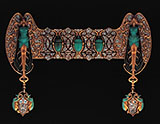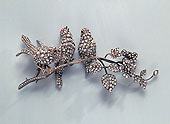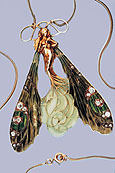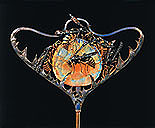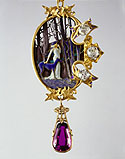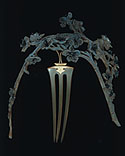The browser will either open the file, download it, or display a dialog.
|
Modern Jewellery's Paternity? Lalique at the Musée du Luxembourg René Lalique, Bijoux d'exception,1890-1912 |
||||||
| One may doubt if many aficionados of nineteenth-century art, whether worldwide or on a more modest scale, would be greatly impressed by the key shibboleths of Modernism: less is more, form must follow function, and decoration is a crime. Certainly one cannot approach the work of René Lalique from the point of view of an admirer of any of these. The exhibition of Lalique's jewellery that was displayed at the Luxembourg Museum in Paris demonstrated everything that Modernism reacted against, and in doing so revealed just how Modernism failed to appeal to the heart or the sensual consciousness. The point is not a mere rhetorical flourish. Much of Lalique's reputation at the time stemmed from his being hailed by Emile Gallé as the 'inventor of modern jewellery'. One can only add, yes, perhaps, but certainly not the grandfather. | ||||||
|
Fig. 1. Decoration is a crime? | |||||
| The exhibition was the 1890s in miniature—quite literally, for much of the work was on the smallest scale. Here were all the emblems of æstheticism: the butterflies of Whistler, the peacocks of Beardsley, the bats of Montesquiou, made as brooches, rings, bracelets, displayed in subtle lights and well designed vitrines that would have done credit to a Cartier or Van Cleef shop. Lalique himself had begun work in 1880 as a jeweller, but it was as a designer that he was to make his mark. | ||||||
| The glass, for which Lalique earned himself a second round of fame (born in 1860, he lived until 1945), was less in evidence, but this was more than simply an unmediated display of objets d'art. We were shown designs, photographs and portraits from the period, backed by storyboards; although it was not always clear how much was the work of Lalique himself and how much the atelier de Lalique. The assemblage clearly owed much to the experience of its commissaires—more than fifty years for Yvonne Brunhammer, dating to her joining the Musée des Arts décoratifs in 1950, and for Dany Sautot, not least her stint as curator of the Musées Baccarat from 1993 to 2002—and to that of its designer (or 'scénographe'), Hubert Le Gall, who was responsible for, among others, the huge exhibition on Melancholy at the Grand Palais in 2005. | ||||||
| Fig. 2: Less is more? | ||||||
| Nevertheless, one cannot see an exhibition such as this one with eyes that have not been influenced by later taste, and there were moments when one wondered if Lalique after all was to Art Nouveau what Chiparrus was to Art Déco, and that his taste, or at any rate that of his clients, was fallible. It was after all an age of very conspicuous consumption, and the women covered with jewels that attracted the sardonic eye of Sargent were hardly the best examples of understated elegance. | ||||||
| Figs.3 & 4: Form follows function? | ||||||
| The woman covered with jewels was after all the alternative title to Wilde's unfinished play 'La Sainte Courtisane', and can be seen to relate the stories of the grandes horizontales such as La Païva or Liane de Pougy appearing covered in jewels and possibly nothing else. The relationship that one has to explore here is not really that of function and form, but of design and setting. Much of Lalique's work can be thought of as pictures, a subject in a frame, just as his materials seem to have been chosen more for their decorative and symbolic values than for their costliness, with a preference for enamel, moonstones and opals. This was high æstheticism: such stones were not only valued for their beauty or even for their symbolism, but for the sound of their names, recitations of these, well-known among the writings of the Æsthetic movement, finding their way even into Conan Doyle and Kipling. The knowing viewer enters into a web of referents that might have surprised Lalique himself. | ||||||
| Even so, Lalique knew what he was doing—where he was at, as we might say. His mistress (and eventual second wife) was from a family of sculptors that was close to Rodin; he himself exhibited regularly at the annual Salon de la Société des Artistes Français. Art plus the fashionable; Lalique had a flair for it. Not for nothing was his connection with glass fostered by the perfume manufacturer François Coty, for whom he made his first flacons in 1909. A connection with Sarah Bernhardt was also fruitful since Lalique made the jewellery that she wore in Gismonda (1894), for which the poster by Mucha is so familiar. The relationship between actress and jeweller was well documented here—better, indeed, than in the standard biographies of Bernhardt—and was well suited to the 'barbaric' aspect of Lalique's taste (one sees here a Byzantine influence, or what was thought at the time to be Byzantine, when Byzantine art was held to be both decadent and barbaric). | ||||||
| This confluence of the great names of art nouveau continued when, in 1895, Lalique participated in Bing's first art nouveau Salon. Although his post-1918 work fell outside this exhibition, one can here note that he made the transition into the twenties and thirties with ease, and art deco was for him very much a new aspect of his younger self, perhaps best summed up in his décor of the immense dining room of the transatlantic liner the Normandie in 1935. It was, of course, the first class dining room. | ||||||
| This is to suggest that one was often in the presence not so much of virtuosity but of ingenuity, of craftsmanship for its own sake. The exhibition thus became illustrative not simply of itself but of the taste of the period, and we were left examining context rather than text, documentation rather than document. Is this too austere a critique? Why should a dyed-in-the-wool fin-de-siècliste such as myself have these doubts? Perhaps because this is a man's view: certainly the women who were there at the same time as myself seemed to be much more appreciative. Perhaps it was the ambience: the dim light, with which we are now very familiar in exhibitions, seemed to be there to evoke reverence, a dim, religious, light: we were not being called upon merely to admire, but to adore. The approach was less through the eye of Sargent, more of Helleu or Boldini, perhaps, and the Marchesa Casati with her borzoi was never far away. | ||||||
|
Fig. 5: A familiar portrait? | |||||
| Lalique's work reached its apogee with his success at the Paris Exposition Universelle in 1900, itself marking the high point of the series that had begun in 1867, and which has passed into a sort of collective æsthetic memory in the way that the subsequent St. Louis World Fair or the post 1918 fairs have never done. It is customary to associate the Edwardian era in England with a decline in taste, but in France, where the concept of Victorianism is understood, Edwardianism is less defined. If Lalique really did crown his career in 1900, there is an implication that his subsequent work was less admirable. The Musée de Luxembourg certainly provided the opportunity to scrutinize the work with this in mind, even though the crowded galleries were not conducive to lengthy pauses over particular items, a situation very familiar at exhibitions such as this one. Fortunately, the magnificent catalogue enabled one to by-pass this disadvantage. Running to nearly three hundred pages under the editorship of Yvonne Brunhammer, and with well over three hundred illustrations, it contains a number of essays of sufficient scholarship and specialisation to make their enumeration desirable: they are given as an appendix to this review, with the catalogue's publication details. At 39 euros, it is a remarkable bargain. | ||||||
| How best, then, to sum up this exhibition, that was at the same time magnificent in its conception, superb in its execution, and somewhat disquieting in its effect? Perhaps the key lies in the problem that surrounds all exhibitions of objects for use: these ones were not made for museum display, but for display upon a woman. Their severance from this function made them vulnerable, souvenirs of vanished vanities, the bodies that they adorned long returned to the earth, that earth from which the gold and precious stones was once mined, themselves remaining imperishable. Ars longa. | ||||||
|
Fig. 6: Vanity? | |||||
| D. C. Rose oscholars[at]gmail.com |
||||||
|
The Catalogue Table of Contents 13. L'époque Lalique – Yvonne Brunhammer 17. A la recherché du bijou moderne – Yvonne Brunhammer 64. Catalogue – Yvonne Brunhammer 69. René Lalique dans la collection Calouste Gulbenkian. Des matériaux à la virtuosité de la technique – Maria Fernanda Passos Leite 79. Une « cosmogonie » symboliste de la femme – Yvonne Brunhammer 134. Catalogue – Yvonne Brunhammer, Marie-Laure Perrin 141. La salade d'Annette et la locomotive de Turner. Petite étude sur le japonisme en littérature – René de Cecatty 151. Images de la nature – Dany Sautot 212. Catalogue – Dany Sautot 219. 1900-1912 – Yvonne Brunhammer 274. Catalogue – Yvonne Brunhammer, Marie-Laure Perrin 281. Chronologie 1860-1945 – Yvonne Brunhammer, Marie Laure-Perrin 284. Orientations bibliographiques 285. Expositions citées en abrégé dans les notices des œuvres |
||||||


